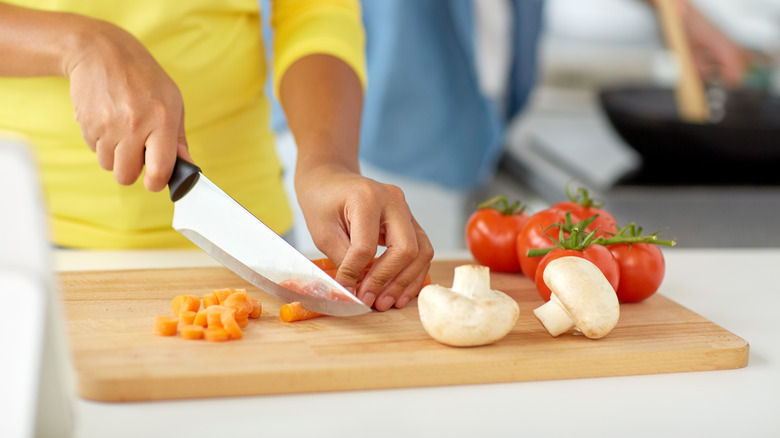How to Sharpen Chef Knife: Tremendous Tips for Barbecue Enthusiasts
Written By James Morgan
As a barbecue enthusiast, you know that a sharp chef knife is crucial for preparing delicious meals. Whether you're slicing through juicy cuts of meat or chopping vegetables for your barbecue sauce, a well-maintained knife can make all the difference. Knowing how to sharpen chef knife not only enhances your cooking experience but also ensures your safety in the kitchen.
In this comprehensive guide, we'll cover everything you need to know about sharpening your chef knife. From understanding the importance of a sharp knife to exploring various sharpening techniques, you'll find exclusive tips that will transform your culinary skills.

Why a Sharp Knife Matters
A sharp knife is essential for several reasons:
- Precision and Control: A sharp knife allows you to make precise cuts, enhancing the presentation and texture of your food.
- Safety: Contrary to what you might think, a sharp knife is safer because it requires less force, reducing the risk of slipping and cutting yourself.
- Efficiency: Sharp knives make your prep work faster and more efficient, allowing you to enjoy your barbecue sooner.
Understanding Knife Sharpness
Before you start sharpening, it's important to understand what makes a knife sharp. The sharp edge of a knife is a result of an acute angle formed by two sides of the blade. Over time, this edge can become dull due to regular use. A dull knife has a rounded edge, making it less effective and more dangerous to use.

Tools You Need for Sharpening
There are various tools available for sharpening your chef knife. Here are some approved options:
- Whetstone: A whetstone is a tried-and-true tool that allows for precise sharpening. It's available in different grits, ranging from coarse to fine.
- Sharpening Steel: Also known as a honing rod, this tool helps maintain the edge of your knife between sharpenings.
- Electric Sharpener: For those who prefer a quick and convenient option, an electric sharpener can be a remarkable choice.
Choosing the Right Whetstone
When selecting a whetstone, consider the grit level. Coarse grit (200-400) is ideal for repairing a damaged edge, medium grit (1000-3000) is suitable for general sharpening, and fine grit (4000-8000) is perfect for polishing and achieving a razor-sharp edge.
How to Use a Whetstone
Using a whetstone requires a bit of practice, but with these steps, you'll master the technique in no time:
- Soak the Whetstone: Most whetstones need to be soaked in water for about 10-15 minutes before use. Ensure it's fully saturated to avoid damage.
- Position the Knife: Hold the knife at a 20-degree angle against the stone. This angle is crucial for achieving a sharp edge.
- Sharpen the Blade: Start with the coarse grit side of the stone. Using gentle pressure, glide the knife back and forth across the stone, maintaining the 20-degree angle. Repeat this process on both sides of the blade.
- Switch to Fine Grit: After achieving a sharp edge with the coarse grit, switch to the fine grit side of the stone for polishing. Repeat the same sharpening technique.
- Rinse and Dry: Once you're satisfied with the sharpness, rinse the knife and whetstone with water. Dry both thoroughly to prevent rusting.
:max_bytes(150000):strip_icc()/faw-chefs-knives-2-test-paudin-pro-8in-nsimpson-296-b0c27d6346ef4e0590c865f69f5453a6.jpeg)
Maintaining Your Sharp Knife
Keeping your knife sharp is an ongoing process. Here are some life-changing tips to maintain your knife's edge:
- Regular Honing: Use a sharpening steel or honing rod regularly to realign the edge of your knife.
-
Proper Storage: Store your knives in a knife block, magnetic strip, or blade guard to protect the edge.
-
Periodic Sharpening: Depending on usage, sharpen your knives every few months to maintain their performance.
- Incorrect Angle: Maintaining the right angle is crucial for effective sharpening. A consistent 20-degree angle is recommended.
- Excessive Pressure: Applying too much pressure can damage the blade. Use gentle, even strokes for best results.
- Skipping Grit Levels: Progress through the grit levels systematically. Starting with coarse grit and finishing with fine grit ensures a sharp and polished edge.
- How often should I sharpen my chef knife? It depends on how frequently you use it. For regular use, sharpening every 3-6 months is recommended.
- Can I use a sharpening stone for other knives? Absolutely! Sharpening stones are versatile tools suitable for various types of knives.
- Is it safe to sharpen my chef knife at home? Yes, with proper technique and tools, sharpening your knife at home is safe and effective.
- How to Use a Chef Knife
- How to Sharpen Chisel Cut Knife
- How to Cut Bread Without Serrated Knife
- How to Safely Cut Fruits and Vegetables

Common Mistakes to Avoid
When sharpening your chef knife, avoid these common mistakes:
FAQs
Additional Resources
For more tips on knife maintenance and usage, check out these exclusive articles:
As an Amazon Associate, I earn from qualifying purchases.



